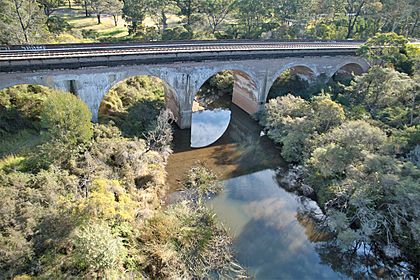Bargo railway viaduct facts for kids
Quick facts for kids Bargo Railway Viaduct |
|
|---|---|

The Bargo railway viaduct, pictured in 2010
|
|
| Coordinates | 34°14′12″S 150°34′48″E / 34.2366°S 150.5799°E |
| Carries | Main Southern railway |
| Crosses | Bargo River |
| Locale | Bargo, Wollondilly Shire, New South Wales, Australia |
| Owner | RailCorp |
| Characteristics | |
| Design | Arch viaduct |
| Material | Brick |
| Total length | 76 metres (249 ft) |
| Longest span | 15.2 metres (50 ft) |
| History | |
| Contracted lead designer | New South Wales Government Railways |
| Construction end | 1919 |
| Official name: Bargo Railway Viaduct; Bargo River Railway Viaduct | |
| Type: | State heritage (built) |
| Designated: | 2 April 1999 |
| Reference #: | 1024 |
| Type: | Railway Bridge/ Viaduct |
| Category: | Transport - Rail |
The Bargo Railway Viaduct is a special bridge that carries trains over the Bargo River in New South Wales, Australia. It's located near Bargo, about 96 kilometres (60 mi) from Sydney. This impressive bridge was built in 1919 and was designed by the New South Wales Government Railways. It's also known as the Bargo River Railway Viaduct. Today, it is owned by RailCorp, a government agency. Because of its history and design, it was added to the New South Wales State Heritage Register in 1999.
Contents
Why Was This Bridge Built?
Improving Train Travel
In the early 1900s, many railway lines in New South Wales had only one track. This wasn't enough for the growing number of trains, especially on busy routes like the Main South Line. To make train travel faster and safer, plans were made to add more tracks. This project also aimed to make the railway lines less steep and less curvy.
The "Brick Arch Era"
A big part of this railway upgrade happened between 1910 and 1923. During this time, many bridges were built using bricks, especially in the form of brick arches. This was because it was hard to get expensive steel from other countries. Also, the government wanted to use local materials as much as possible. So, even for shorter bridges, brick arches were often chosen instead of steel.
Huge amounts of bricks were used for these projects. This period is sometimes called the "era of brick arch construction." After 1923, steel made in Australia became more common. Steel then replaced bricks for the main parts of bridges, but bricks were still used for the supports and walls.
The Main South Line Upgrade
The Main South Line was the biggest railway line to be upgraded. It was already duplicated to Picton by 1892. Then, from 1913 to 1922, the duplication was extended all the way to Cootamundra, which is about 343 kilometres (213 mi) away. The Bargo Railway Viaduct was an important part of this large project.
Safer and Faster Journeys
One key goal of the duplication project was to get rid of level crossings. These are places where roads cross railway tracks at the same level. By building bridges like the Bargo Viaduct, trains could pass over rivers and roads, making journeys much safer and faster for both goods and passengers.
What the Bargo Viaduct Looks Like
The Bargo Railway Viaduct is a large bridge made of brick. It has five main sections, called spans, each about 15.2-metre (50 ft) long. These spans stretch over the Bargo River. The bridge is still in good condition and looks much like it did when it was first built.
Why This Bridge is Special
The Bargo Railway Viaduct is important for several reasons:
- It was a big part of the major upgrade of the Main South Railway, which helped develop the south-western part of New South Wales.
- The use of bricks helps the bridge fit in with the natural environment around it.
- The railway upgrades helped businesses by allowing more freight trains. They also helped people by making passenger trains faster and better.
- During the "era of brick arch construction" (1910–1923), about 90 railway sites had brick arches. Most of these had clear spans of 6.1 to 13.1 metres (20 to 43 ft). However, the Bargo Viaduct has larger arches, each about 15.2-metre (50 ft) long, which makes it quite unique.
- The bridge still has its original parts and structure, showing how it was built long ago.
The Bargo Railway Viaduct is a great example of brick arch construction from that time. It was listed on the New South Wales State Heritage Register in 1999 because of its historical and architectural importance.

